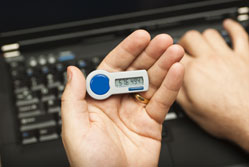Simple protection from cyber criminals
Simple protection from cyber criminals
 Last week’s celebrity hacking news showed just how easy it can be for hackers to gain access to sensitive or personal data.
Last week’s celebrity hacking news showed just how easy it can be for hackers to gain access to sensitive or personal data.
And you don’t need to be a well-known personality to be targeted by hackers. Many hackers target small businesses, because these companies are less likely to have invested in strong security measures.
Someone hacking or compromising your system could be your worst nightmare. But there are some simple ways to prevent it from happening. Here are some steps you can take to make your system safer.
1. Add another layer of verification
Two-step verification is a good way to add another layer of protection when staff log in to company systems.
Typically, two-step verification requires your staff to sign in with something they know (a password), plus something they have (often a one-time code that’s texted to their mobile phone or shown on a digital key fob, pictured).
Two-step verification provides significant extra protection, especially if your company uses its systems to store and share sensitive documents.
2. Use strong passwords
Most people know they need to use strong passwords. But most people still don’t do it.
Make it company policy to use strong passwords. Mixing uppercase letters, lowercase letters, numbers and symbols makes it much harder for someone to gain unauthorised access.
You can use password management tools — like 1Password or LastPass — to keep track of these hard-to-remember logins.
3. Don’t share your logins
Sharing usernames and passwords is a big no-no. If everyone uses the same details to sign in to your shared workspace, if something goes wrong then you don’t have an audit trail to a specific user.
It also creates potential risk when an employee leaves the business. They probably won’t do anything malicious, but are you willing to take that risk?
4. Encrypt important data
Encryption scrambles data so it can’t be read, even if a hacker gets their hands on it.
Windows 7 and Windows 8 both have encryption tools built in. There are plenty of other encryption tools available too —many are free.
Copyright © 2014 Ian Cowley, managing director at Cartridge Save.




Comments
Add a comment